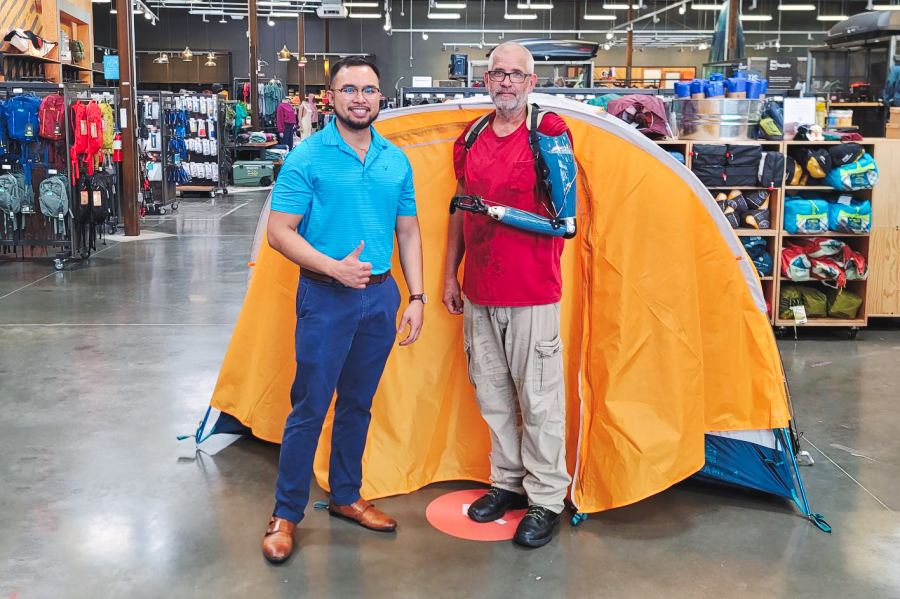For people who have experienced an amputation, they may find themselves with less energy at the end of the day than what they had before their amputation. For people with a congenital limb difference, they may find that overuse issues, either in their sound arm or other parts of their body, are causing them new pains. Both problems can be helped with the use of energy conservation and work simplification.
What these topics really come down to is this: learning how to preserve the energy you have for the tasks you most want to complete; and working smarter, not harder.
There are so many ways to change your home space, workspace and how you operate in general so that you can make yourself more independent, and keep yourself independent for longer.
Our patient Doug, pictured above and below (with his clinical therapy specialist), experienced a traumatic above elbow amputation in early 2022 due to a work accident. He has a body-powered prosthesis with a V2P terminal device that he uses daily. But he knows that his device is a tool — it cannot replace what he lost. For this reason, Doug has made changes to his life that allow him to save his energy and simplify his tasks.
One thing he discussed during an interview in the summer of 2023 was boots. “I like tying my own shoes. I don’t like having to go to my wife like I’m five and putting my shoe in front so she can tie it. I don’t like doing that. With a body-powered device, it can be really tricky to tie shoes, it really is. But if you like wearing boots, like I do, they make these boots that have zippers down the side, so you only got to tie them about once a week.”
Doug is also a big camping fan. He’s had to make a few changes since his amputation, but he’s looking forward to his next camping trip in the fall, once the Texas heat calms down. “I went with my clinical therapy specialist to REI to practice setting up a tent. There’s no way I could do that without my prosthesis. But I put that four-man tent together, by myself, in about 45 minutes, with the prosthetics.” Doug put the tent up on his own (watch him do the work in the video below), but he did need help to take it down. “‘Cause my arm and my shoulder was starting to get real sore. But realistically, when I go camping, I’m not gonna have to set it up, then take it right back down. I can set up that tent myself, then take a break. I won’t have to take it down for a couple of days.” That knowledge, that Doug will need a break after an arduous, though enjoyable task, is an excellent understanding of energy conservation. As people with a limb difference look at their days, built-in breaks may be both necessary and welcome. “And now I can use that as a gauge, I can get there at like three o’clock, get everything set up, then I can take my arm off and let it rest.” For more information about structuring one’s day to reflect what they think they’re capable of, see our article on “Spoon Theory.”
When Doug goes camping, he likes to go fishing. “I have a wagon and I load up all the gear I’ll need in advance. I don’t have to carry all that stuff down to the river or lake, I can pull the wagon, and for that I just need my sound hand.” Another great example of work simplification: if you can get the same result with less energy expenditure, you’re allowing yourself more time to enjoy the goal.
There are more ways to employ both of these strategies. Check out our articles, “Life Hacks for People with Upper Limb Loss,” “Using Universal Design in Home Remodeling for People with a Limb Difference,” “Kitchen Organization and Set Up for People with an Upper Limb Difference” and “Clothing Options for People with an Upper Limb Difference.”
Doug is what his case manager called a “super user” when it comes to using his prosthesis. While he’s aware that his device is a tool, he’s eager to use it and knows how to adapt. Doug hopes that other people will take his examples and apply them to their own lives. When Doug first got his prosthesis, he was overusing it. Doug reported to his clinical team that he was experiencing skin issues. “I was wearing that liner too long — that’s what was causing the issues.” But he’s started to figure out where the devices limits are and where his limits are. “You can’t do all the things you used to be able to do without your old limb. But with a prosthesis, you can get close.” Doug puts that to the test every day.
If you are interested in learning more about how our clinical teams can help you achieve more, please contact us. We offer complimentary consultations, either in person or via video chat. If you would like to comment on this topic, please do so below. We thank Doug for his time, and we hope you have found this article helpful.







%20President%20and%20Senior%20Clinical%20Director.jpg?width=600&height=600&name=John%20M.%20Miguelez%2c%20CP%2c%20FAAOP(D)%20President%20and%20Senior%20Clinical%20Director.jpg)










No Comments Yet
Let us know what you think